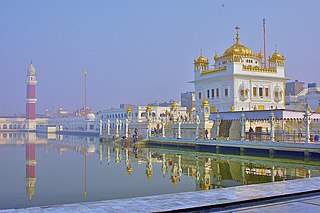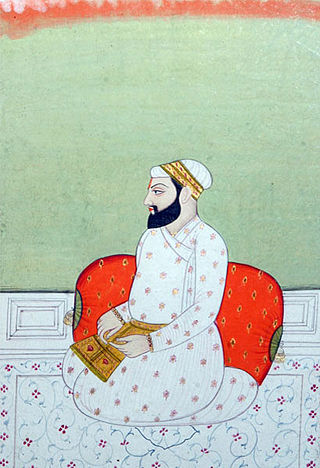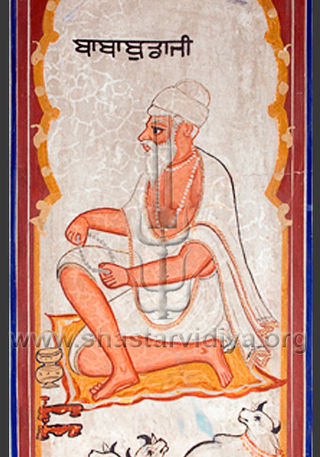| |||||
| Centuries: | |||||
|---|---|---|---|---|---|
| Decades: | |||||
| See also: | List of years in India Timeline of Indian history | ||||
Events from the year 1598 in India.
| |||||
| Centuries: | |||||
|---|---|---|---|---|---|
| Decades: | |||||
| See also: | List of years in India Timeline of Indian history | ||||
Events from the year 1598 in India.
The first known English use of zero was in 1598.

Guru Amar Das, sometimes spelled as Guru Amardas, was the third of the Ten Gurus of Sikhism and became Sikh Guru on 26 March 1552 at age 73.

Jijabai Bhonsle (or Bhonsale, Bhosale, Bhosle) or Jadhav, referred to as Rajmata, Rastramata, Jijabai or Jijau, was the mother of Chattrapati Shivaji, founder of the Maratha Empire. She was a daughter of Lakhujirao Jadhav of Sindkhed Raja.

Tarn Taran Sahib is a city in the Majha region of the state of Punjab, in northern India. It is the district headquarters and hosts the municipal council of Tarn Taran district. Gurdwara Sri Tarn Taran Sahib, a prominent Sikh shrine is located in the central part of the city.

Goindwal, also known as Goindwal Sahib and alternatively transliterated as Goindval, is located in the Taran Taran district of the Majha region of Punjab, India about 23 km from Tarn Taran Sahib. In the 16th century it became an important center for the Sikh religion during the Guruship of the Guru Amar Das Ji. Goindwal is on the banks of the river Beas and is one of the focal points of small scale industries of Tarn Taran district.
Ashta Pradhan was a system of ministerial delegation in the Maratha empire. The council is credited with having implemented good governance practices in the Maratha heartland, as well as for the success of the military campaigns against the Mughal Empire.

Mata Gujri, also spelt as Mata Gujari, was the wife of Guru Tegh Bahadur, the ninth Guru of Sikhism, and the mother of Guru Gobind Singh, the tenth Guru of Sikhism. She played a central role in the history of Sikhism and is one of the four consorts bestowed with the title of Guru-Mahal.
Guru Nanak founded the Sikh faith in the Punjab region of the northern part of the Indian subcontinent in the end of fifteenth century. He was first of the ten Sikh Gurus. The tenth, Guru Gobind Singh, formalised its practices on 13 April 1699. He baptised five Sikh people from different parts of India, with different social backgrounds, to form Khalsa fauj. Those five Beloved Ones, the Pañj Piārē, then baptised him into the Khalsa fold. This gives the order of Khalsa a history of around 500 years. Historical theory and analysis suggests that Sikhism came into existence during the early Medieval period of the Bhakti movement and also after repeated invasions by Muslim rulers upon the Hindu community during Mughal rule, which lasted between especially in the region of North India.
Sindkhed Raja is a town and a municipal council in Buldhana district in the Indian state of Maharashtra. It is the birthplace of Jijabai, mother of Shivaji.

Varan Bhai Gurdas, also known as Varan Gyan Ratnavali, is the name given to the 40 vars which is traditionally attributed to Bhai Gurdas.

Bhai Gurdas was a Sikh writer, historian and preacher who served as the Jathedar of the Akal Takht from 1606 to his death in 1636. He was the original scribe of the early version of Guru Granth Sahib.

Bibi Bhani, also known as Mata Bhani, was the daughter of Guru Amar Das, the third Sikh Guru. She played a central role in the history of Sikhism and is one of the four consorts bestowed with the title of Guru-Mahal.

Maharani Saibai Bhosale was the first wife and chief consort of Chattrapati Shivaji, the founder of the Maratha Empire. She was the mother of her husband's successor Chattrapati Sambhaji.

Guru Ram Das was the fourth of the ten Sikh gurus. He was born in a family based in Lahore. His birth name was Jetha, and he was orphaned at age seven; he thereafter grew up with his maternal grandmother in a village.

The Lal Mahal of Pune is one of the most famous monuments located in Pune, India, where Shivaji I, founder of the Maratha Empire spent his childhood.
Events from the year 1535 in India.

Guru Arjan was the fifth of the ten total Sikh Gurus. He compiled the first official edition of the Sikh scripture called the Adi Granth, which later expanded into the Guru Granth Sahib. He is regarded as the first of the two Gurus martyred in the Sikh faith.

In Hinduism and Sikhism, a samadhi or samadhi mandir is a temple, shrine, or memorial commemorating the dead, which may or may not contain the body of the deceased. Samadhi sites are often built in this way to honour people regarded as saints or gurus in Hindu religious traditions, wherein such souls are said to have passed into mahāsamādhi, or were already in samadhi at the time of death.
The Piri system was part of the Sikh missionary administrative organization founded by the third Sikh guru, Guru Amar Das, for the purpose of propagating Sikhism amongst women. The system was significantly expanded by the seventh Sikh guru, Guru Har Rai. Each Piri was a Sikh missionary seat and administrative unit. The Piris were sub-centres under the Manji dioceses.

Baba Buddha was a prime figure in early Sikhism.

Mansa Devi was the wife of the third Sikh guru, Guru Amar Das.